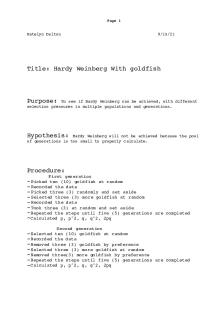Hardy Weinberg problems PDF

| Title | Hardy Weinberg problems |
|---|---|
| Course | Evolution, Ecology, and Biodiversity |
| Institution | University of California Los Angeles |
| Pages | 2 |
| File Size | 48.5 KB |
| File Type | |
| Total Downloads | 29 |
| Total Views | 160 |
Summary
Professor - Deborah Pires
Practice questions for Hardy-Weinberg Equilibrium...
Description
Hardy-Weinberg practice problems Recall what the H-W law states: If in a large populations, p, is the frequency of allele A1 and q is the frequency of allele A2, then after one generation of random mating the genotype frequencies will attain and remain at: A1A1 = p2, A1A2 = 2pq and A2A2 = q2 in the absence of selection, mutation, drift and migration. Unstated properties of the H-W principle are: the trait is autosomal, the sexes are in equal frequency and the organisms are diploid. Consider the following problem: In a population there is a gene where the allele frequencies for that gene are equal (there are only two alleles for this gene – A and a). What are the expected genotype frequencies given the allele frequencies, assuming the population is in H-W equilibrium? How do you go about this problem? Here’s the information you know: 1. allele frequencies are equal. p = q 2. allele frequencies always equal one. p + q = 1 therefore: 2p = 1, p = 0.5 and q = 0.5 Now that you have the allele frequencies you can determine the genotype frequencies AA = p2 = (0.5)2 = 0.25 Aa = 2pq = 2(0.5)(0.5) = 0.5 aa = q2 = (0.5)2 = 0.25 You can check yourself because the genotype frequencies for all possible genotypes should also equal one, and in this example they do add to one.
Consider the following problem: You are given the following information about a population: There are two alleles C and c. C codes for green hair and c codes for white hair. C is dominant over c, in the heterozygous state, individuals will have green hair. The frequency of the c allele is 0.3. Assuming the population is in H-W equilibrium what are the genotype frequencies? 1. start by determining the other allele frequency, in this case C: 1 – 0.3 = 0.7 One minus the frequency of c will equal the frequency of C. 2. determine what each of the possible genotype combinations are: Homozygous dominant CC = (0.7)2 = 0.49 Heterozygous Cc = 2(0.7)(0.3) = 0.42 Homozygous recessive cc = (0.3)2 = 0.09
Let’s look at a similar situation with the same alleles. In a population of 100 individuals there are 36 individuals with white hair. What are the allele frequencies of C and c, and how many individuals have the genotype CC? You can solve a problem like this by taking the following steps: 1. You know that individuals with white hair have the genotype cc. We can call C allele p, and the c allele q. This frequency of individuals with white hair equals q2. The frequency of white-haired individuals in the population = 36/100 = 0.36 So, 0.36 = q2. Take the square root of 0.36 and you will have the frequency of q (or allele c) in the population. 0.36 = 0.6 2. You know that p + q = 1 the frequency of p = 1 – q. p = 1- 0.6 = 0.4 3. The frequency of the genotype CC = p2, so (0.4)2 = 0.16 the question asks for the number of individuals with the CC genotype so 0.16(100) = 16. Sixteen is the number of individuals with the CC genotype. Problems...
Similar Free PDFs

Hardy Weinberg problems
- 2 Pages

Hardy Weinberg Problems T FB
- 3 Pages

LP hardy weinberg
- 15 Pages

Koi Fish Hardy-Weinberg
- 8 Pages

Hardy Weinberg lab report
- 11 Pages

Genetika populasi hardy-weinberg
- 13 Pages

Hardy weinberg questions
- 3 Pages

Legge di Hardy-Weinberg
- 2 Pages

AP Bio Applying Hardy-Weinberg
- 4 Pages

Lab report of Hardy Weinberg
- 4 Pages

Hardy-weinberg Green Monkey Key
- 1 Pages

03-Lei de Hardy-Weinberg
- 9 Pages

Chapitre 1 Modèle de Hardy-Weinberg
- 11 Pages
Popular Institutions
- Tinajero National High School - Annex
- Politeknik Caltex Riau
- Yokohama City University
- SGT University
- University of Al-Qadisiyah
- Divine Word College of Vigan
- Techniek College Rotterdam
- Universidade de Santiago
- Universiti Teknologi MARA Cawangan Johor Kampus Pasir Gudang
- Poltekkes Kemenkes Yogyakarta
- Baguio City National High School
- Colegio san marcos
- preparatoria uno
- Centro de Bachillerato Tecnológico Industrial y de Servicios No. 107
- Dalian Maritime University
- Quang Trung Secondary School
- Colegio Tecnológico en Informática
- Corporación Regional de Educación Superior
- Grupo CEDVA
- Dar Al Uloom University
- Centro de Estudios Preuniversitarios de la Universidad Nacional de Ingeniería
- 上智大学
- Aakash International School, Nuna Majara
- San Felipe Neri Catholic School
- Kang Chiao International School - New Taipei City
- Misamis Occidental National High School
- Institución Educativa Escuela Normal Juan Ladrilleros
- Kolehiyo ng Pantukan
- Batanes State College
- Instituto Continental
- Sekolah Menengah Kejuruan Kesehatan Kaltara (Tarakan)
- Colegio de La Inmaculada Concepcion - Cebu


